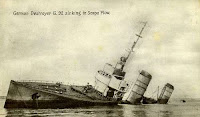The CARPATHIA RMS was famed for rescuing the passengers of the TITANIC disaster. She was built in 1902 by C.S.Swan & Hunter, Wallsend-on-Tyne (engines by Wallsend Slipway Co Ltd) for the Cunard SS Co. She was a 13.555grt, length 540ft xbeam 64,5ft, one funnel, four masts, twin screw and a speed of 14 knots. There was passenger accommodation for 204-2nd class and 1.,00-3rd class. Launched on 6/8/19 02, she sailed on her maiden voyage from Liverpool to Queenstown (Cobh) and Boston on 5/5/1903.
After this voyage, she transferred to the Liverpool - Queenstown - New York service on 28/5/1903. On 24/11/1903 she commenced her first New York - Trieste sailing with 1st and 3rd class passengers and on 17/5/1904 resumed New York - Queenstown - Liverpool. On 29/11/1904 she went back to the New York - T rieste route and on 30/5/1905 resumed the New York - Queenstown - Liverpool service. She started her last voyage on this route on 19/9/1905 and was then refitted to carry 100-1st, 200-2nd and 2.250-3rd class passengers. She resumed sailings between Trieste, Fiume, Palermo and New York on 27/10/1905 and on 18/4/1912 arrived in New York with 700 Titanic survivors. She commenced her last Piraeus - Me ssina - Palermo - Naples - Genoa - Lisbon - New York voyage on 13/4/1915 and transferred to the Liverpool - New York service in July 1915.
On 17/7/1918 she was torpedoed and sunk by the German submarine U-55, 170 miles west by north of Fastnet, Ireland with the loss of 5 lives.
Today the ship rests in 155 meters of water, more than 200 miles west of Fastnet Rock in the south of Ireland. The wreck was discovered September 9, 1999 and shot 22. The news was announced by the writer and diver Clive Cussler in 200,021.22. Acquired in 2001 by RMS Titanic Inc. (already in possession of the Titanic), it is sold to the company Seaventures in February 20075.
Cut off the commander of the Carpathia by the survivors of the Titanic stayed on the ship to its sinking. It is therefore likely that it is still inside the wreck. The wreck is regularly visited by divers and several objects were reassembled and restored
Another video of diving in Carpathia
http://www.youtube.com/watch?v=C6-pSYdPraM
After this voyage, she transferred to the Liverpool - Queenstown - New York service on 28/5/1903. On 24/11/1903 she commenced her first New York - Trieste sailing with 1st and 3rd class passengers and on 17/5/1904 resumed New York - Queenstown - Liverpool. On 29/11/1904 she went back to the New York - T rieste route and on 30/5/1905 resumed the New York - Queenstown - Liverpool service. She started her last voyage on this route on 19/9/1905 and was then refitted to carry 100-1st, 200-2nd and 2.250-3rd class passengers. She resumed sailings between Trieste, Fiume, Palermo and New York on 27/10/1905 and on 18/4/1912 arrived in New York with 700 Titanic survivors. She commenced her last Piraeus - Me ssina - Palermo - Naples - Genoa - Lisbon - New York voyage on 13/4/1915 and transferred to the Liverpool - New York service in July 1915.
On 17/7/1918 she was torpedoed and sunk by the German submarine U-55, 170 miles west by north of Fastnet, Ireland with the loss of 5 lives.
Today the ship rests in 155 meters of water, more than 200 miles west of Fastnet Rock in the south of Ireland. The wreck was discovered September 9, 1999 and shot 22. The news was announced by the writer and diver Clive Cussler in 200,021.22. Acquired in 2001 by RMS Titanic Inc. (already in possession of the Titanic), it is sold to the company Seaventures in February 20075.
Cut off the commander of the Carpathia by the survivors of the Titanic stayed on the ship to its sinking. It is therefore likely that it is still inside the wreck. The wreck is regularly visited by divers and several objects were reassembled and restored
Another video of diving in Carpathia
http://www.youtube.com/watch?v=C6-pSYdPraM





























-greece.jpg)


